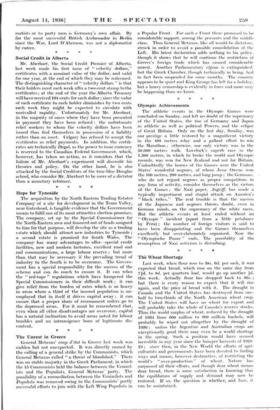Last week, when flour rose to 38s. 6d. per sack,
it was expected that bread, which rose on the same day from 74d. to 8d. per quartern loaf, would go up another id. this week. Actually flour has dropped back to 86s. ; but there is every reason to expect that it will rise again, and the price of bread with it. The drought in Canada and the United States has destroyed from one- half to two-thirds of the North American wheat crop. The United States will have no wheat for export and will probably take the whole of Canada's reserve stocks. Thus the world surplus of wheat, reduced by the drought of 1934 from. 600 million to 300 million bushels, will probably be wiped out altogether by the drought of 1936 ; unless the Argentine and Australian crops are exceptionally good there may even be a world shortage in the spring. Such a position would have seemed incredible in any year since the bumper harvests of 1928- 29 ; since then, in the New World the efforts of agri- culturists and governments have been devoted to finding ways and means, however destructive, of restricting the world's " over-production " of wheat. Nature has surpassed all their efforts, and though dear wheat means dear bread, there is some satisfaction in knowing that the equilibrium of supply and demand may now be restored. If so, the question is whether, and how, it can be maintained.






































 Previous page
Previous page